Outdoor athletes with gluten sensitivities needn't look far to find gluten-free energy and protein bars. An increasing number of gluten-free (GF) specialty foods are being offered, good news for the 1 in 133 Americans with celiac disease who can't digest the protein in wheat, barley, and rye and need a gluten-free diet. Also beneficial for those with wheat allergies (the autoimmune celiac disease and wheat allergies are different, but many GF foods are wheat-free).
Wondering what the GF fuss is about, and if you should go gluten-free?
GF proponents claim anti-inflammatory and other physical benefits from a gluten-free diet. Notably, the Garmin-Cervélo professional cycling team went gluten free in 2008, and a Google search will yield numerous athletes, elite and recreational, who credit a gluten-free diet for improved performance.
However, “eating gluten-free is not meant to be a diet craze,” says Rhonda Kane, a registered dietitian and consumer safety officer at the U.S. Food and Drug Administration. “It’s a medical necessity for those who have celiac disease. There are no nutritional advantages for a person not sensitive to gluten to be on a gluten-free diet.”
Whether you go gluten-free out of lifelong necessity or by choice, here are some of the gluten-free energy and protein bars available to fuel your outdoor activities.
Share your own gluten-free outdoor food recommendations in a review, a comment below, or in a GF outdoor recipe in our Camp Kitchen Recipes forum.
Bobo's Oat BarsStarted by a Boulder, Colo., mom in 2005, Bobo's makes four gluten-free oat bars (peach, maple pecan, lemon poppyseed, and chocolate almond) in addition to its ten regular oat bars. All are baked from scratch using organic and vegan ingredients. |
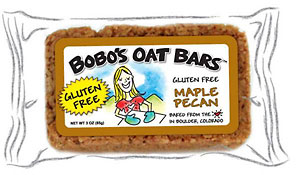 |
Bonk BreakerBonk Breaker energy and protein bars were cooked up by triathlete Jason Winn in 2005, and are the official energy bar of Ironman. All 10 flavors are free of gluten, dairy, and soy, and use 100-percent gluten-free oats grown in fields and on farms that do not grow gluten-containing grains. Bonk Breakers are baked fresh weekly. Peanut Butter & Jelly is the original. |
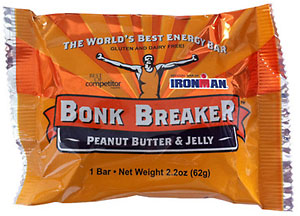 |
ClifSorry, there's no gluten-free versions of standard Clif Bars, but Luna Protein bars and Kit’s Organic Fruit and Nut bars from Clif are gluten-free. New this year, Kit's Organic bars are certified organic, soy-free, and dairy-free, and come in four flavors (berry almond, cashew, chocolate almond coconut, and peanut butter). If you have other dietary concerns (nuts, dairy, soy, etc.), you can compare offerings on the Clif website. |
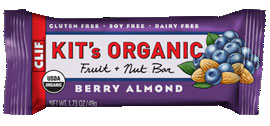 |
Honey StingerHoney Stinger says its protein bars, available in 10g and 20g sizes, "do not have any gluten but they are made in a facility that processes gluten. In between production runs the lines are meticulously cleaned." All Honey Stinger bars are made with more than 30 percent USDA certified organic honey. |
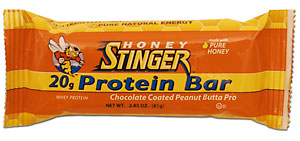 |
KINDAll KIND fruit and nut snack bars are 100 percent gluten-free, including the original Fruit and Nut bars in 11 flavors and Fruit and Nut Plus in eight flavors. KIND's products are tested for gluten and meet the FDA’s proposed requirement of 20 ppm of gluten, says the company (see certification below). "The manufacturing plant is dedicated gluten free and has a strict allergen control program." |
 |
LÄRABARAll LÄRABAR, über, and Jŏcalat products are gluten free. The company uses no gluten-containing ingredients, and says it has manufacturing controls in place "to ensure that there are no cross-contact concerns. We also periodically verify our practices using Gliadin gluten testing" (gliadin is a glycoprotein present in wheat). |
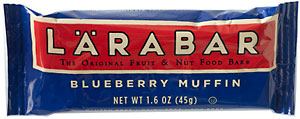 |
NOWFrom New Zealand and Amazing Race host Phil Keoghan come NOW (No Opportunity Wasted) bars with a 4:1 carb-to-protein ratio. NOW bars are manufactured in a facility approved and certified by testing of the Gluten-Free Certification Organization (see certification below) and come in five flavors: peanut and caramel, honeycomb with chia and raisins, manuka honey, manuka honey strawberry, and white chocolate fruit and nut. |
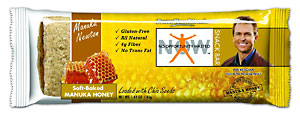 |
ProBarFruition bars are PROBAR's gluten-free offering. The fruit-based snack bars come in seven flavors (blueberry, cherry, chocolate orange, cran-raspberry, lemon, peach, and strawberry) and are made with oats, chia seeds, and cashews. ProBar reformulated the Fruition recipe to be gluten-free this spring, and has had the bars independently certified as gluten-free.
|
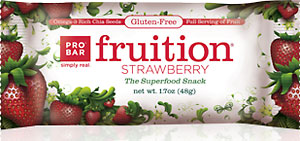 |
PurePure uses no wheat or wheat family products in its bars, and its bars are gluten-free, kosher, organic, and vegan. Pure says, "the facility where our bars are processed is not wheat-free, but contamination is virtually impossible given the measure of cleanliness required by organic standards." |
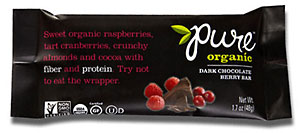 |
YouBarIf you want a customized bar, but don't want to make your own, YouBar lets you select the ingredients, including gluten-free ones, to build your own personal energy or protein bar, complete with custom label. However, "your recipe may contain traces of gluten because our kitchen also processes recipes with gluten," says the company. |
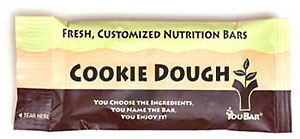 |
ZingAll Zing bars are certified gluten-free and are also soy- and corn-free. Three of the six flavors (chocolate coconut, peanut butter chocolate chip, and cashew cranberry orange) are also dairy-free and vegan. |
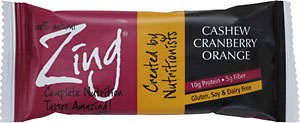 |
Other Options
Numerous other gluten-free bars abound, including GFB (the Gluten Free Bar), NoGii bars from celiac and TV personality Elisabeth Hasselbeck, "athlete-designed" Picky Bars with a 4:1 carb-to-protein ration, and PureFit nutrition bars.
Share your GF energy bar and outdoor food recommendations in a review.
At anywhere from a buck to three a bar, you may want to make your own. Post your outdoor food recipes (gluten-free or gluten-full) in our Camp Kitchen Recipes forum.
Gluten-Free Certification
So what does "gluten-free" mean? It depends, but it does not necessarily mean 100 percent free of gluten. Rather, it indicate no or very low levels of the plant protein. There's no regulation for the term yet, but for voluntary labeling the U.S. Food and Drug Administration has proposed to define "gluten-free" as having less than 20 ppm (read the FDA Q&A).
Several organizations certify products and companies as gluten-free. They include the Gluten Intolerance Group's Gluten-Free Certification Organization (less than 10 ppm gluten), the Celiac Sprue Association (less than 5 ppm gluten), and the National Foundation for Celiac Awareness (less than 10 ppm gluten).
As with any medical or nutritional issue, consult your health care provider to see if a gluten-free diet is right for you.

 by Alicia MacLeay
by Alicia MacLeay









